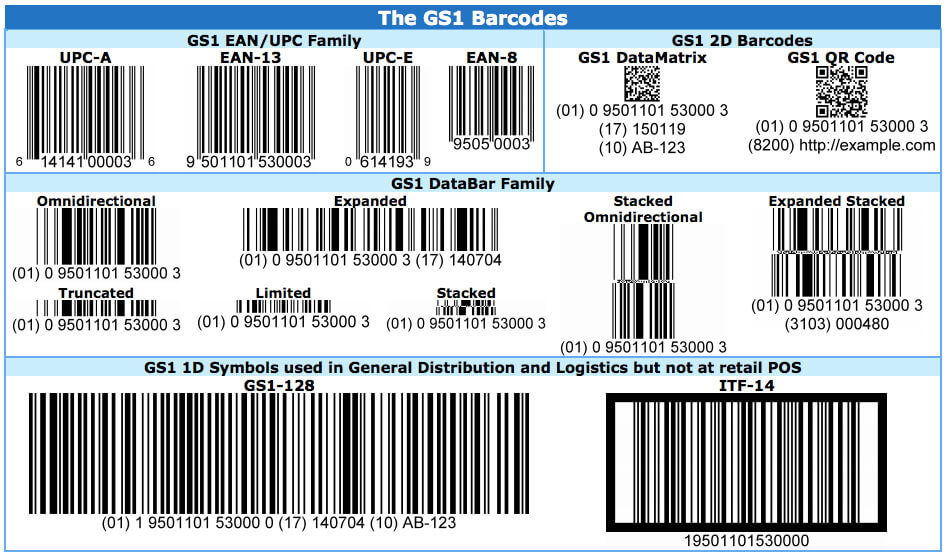Barcodes Registration of Products at a glance
A barcode is “A machine-readable code in the form of numbers and a pattern of parallel lines of varying widths, printed on and identifying a product.”
The lines and patterns on a barcode registration are actually representations of numbers and data and their development allowed basic information about a product to be easily read by an optical scanning device (a barcode scanner) and automatically entered into a computer system. so this massively reduces the time to record products information and eliminates human data entry error.
Barcode systems help businesses and organizations track products, prices, and stock levels for centralised management in a computer software system allowing for incredible so increases in productivity and efficiency.
Because of Barcodes registration started out with simple 1-dimensional designs, consisting of basic black lines only be read by specially designed barcode scanners. However,But today barcodes come in many shapes and sizes and a wide range of designs and many read by mobile phones and other devices.
Benefits of Products Barcode Registration
.jpeg)
Universal Identification of the Product in Barcode registration
Provides unambiguous & universal identification of products so no two products in the world would have the same GS1 barcode number.
Speedy product Listing
Helps with faster listing of products on e-commerce platforms.
A Standard Practice
Meets pre-requisite to doing business with modern trade retailers.
Gives an international look and feel to products..
Accuracy & Faster Billing
Facilitates accurate and faster billing at retail billing counters.
Since the barcode is a unique key to identify a product (via GTIN), but it used to identify products without any ambiguity and place accurate orders for them.
Optimised Inventory Management
With Product Barcodes, company use the technology to maintain accurate control over inventory. For example, warehouses and retailers scan barcodes when products arrive and leave, to take a record of inventory. Some companies link their inventory control to online portals so that they can instantly update package status.
Helps to Maintain Error Free
Enables automated data capture with 100% information accuracy. This helps eliminate human errors,and offering a reliable way to read encoded information.
Documents requirements for Barcode Registration in India
- PAN Card of the Applicant Entity ( for Proprietorship entity, PAN of Proprietor)
- GST Registration Certificate ( Optional- required in case of GST Registered)
- Request Letter for Barcode allotment (on Company Letterhead)
- Copy of Audited Balance Sheet
- Certificate of Incorporation (Company/LLP)
- Partnership Deed ( for Partnership Firm)
- Memorandum and Article of Association ( for Company)
- Cancelled Cheque Copy
What are the Different types of Barcodes Registration?
Different application requires different barcodes with capability to hold different data. Therefore, to diverse requirements, Barcode system standards are used for that distinction between barcodes. But Different types of barcode symbols are also distinction between different barcodes. Barcodes be categorized into the following categories:
EAN/UPC FAMILY BARCODES
EAN/UPC (European Article Number/Uniform Product Code) Family of barcodes is instantly-recognizable barcodes that are printed on virtually every consumer product in the world. They are the longest-established and most widely-used of all barcodes. Used for Retail stores for sales checkout; inventory, etc.
DATABAR FAMILY BARCODES
DataBar barcodes are used to label fresh foods. These barcodes hold information like an item’s batch number or expiry date, in addition to other attributes used at the point-of-sale such the item weight.
1D BARCODES
128 and ITF-14 are highly versatile 1D barcodes that enable items to be tracked through global supply chains. The 128 barcode carry any of the ID keys, plus information like serial numbers, expiration dates and more. The ITF-14 barcode only hold the Global Trade Item Number (GTIN) and is suitable for printing on corrugated materials.
2D BARCODES
Two-dimensional (2D) barcodes look like squares or rectangles that contain many small, individual dots. A single 2D barcode hold a significant amount of information and may remain legible even when printed at a small size or etched onto a product. 2D barcode do much more than because of just keep track of assets and inventory.
Today, 2D codes, especially QR codes, which can hold as much as 7,000 digits or 4,000 characters of text, are used by companies to share information or websites and videos with consumers, or by healthcare facilities to monitor medication, and even to integrate data with programs like MS Office, MS SQL Servers, and other databases and files.
2D barcodes are used in a wide range of industries, from manufacturing and warehousing to logistics and healthcare.

How does Barcodes Registration Works?
Barcodes work through the combination of a symbology (the barcode) and a scanner that read the symbols and convert them into useful information, often information about an item’s origin, price, type, and location. The scanner reads the barcode and automatically enters the information stored in it into a system – often some type of database.
This tool has provided many,and many benefits for businesses. It paved the way for the globally connected distribution channels we now have and it is what allows big Departmental Stores like BigBazaar, Walmart, Pentaloon to ensure they have products properly stocked and priced around the stores located in all cities. It has also become a crucial tool to help small and medium businesses, as well as hospitals and government groups, keep track of assets and improve their efficiencies.
Some of the ways businesses use barcodes include:
- Keeping track of inventory. A basic inventory tracking system consists of software and a barcode scanner or mobile computer. Inventory items (like products you sell, supplies, or raw materials) will all have barcode labels, so when you remove an item from stock, and you just scan the barcode to reduce the available count in your inventory tracking software, instead of having to type in a SKU.
- Keeping track of assets. Any business, no matter how large or small, IT assets and fixed assets. Barcoded asset tags are attached to each individual asset, and scanned to check items in or out in your asset tracking software. It’s a great way to improve accountability and makes audits much easier.
- Use barcodes in return mail. Add a barcode to the return-mail registration postcard that matches the product’s serial number, and then you instantly track which serial numbers are registered, and which aren’t. Plus, your customers won’t have to locate and transcribe a lengthy serial number.
- Include barcodes in a mail merge. If your company is hosting an event, you add barcodes to an RSVP card so you can track because who has responded – without trying to translate anyone’s handwriting.
- Add barcodes to invoices. Add a barcode that represents the customer number or the individual invoice number so when it’s returned with payment, you can easily locate the customer account or invoice number. So This will prevent problems like applying payments to the incorrect customer account or invoice.
Our Barcodes Registration Service Package inclusion
.jpeg)
Consultation
First, Get Consultation from our Consultant to know the Documents Requirements, Registration Cost, Subscription, Barcodes type, Numbers of Barcodes and process of registration.
Preparing Application
Once your documents reached to us, We prepare your application along with the “Product Sheet”. you take more than one barcode in one application subject to maximum limit as per option avail by you. Maximum Barcode limit is 100000.
Application Submission
Once your application is completed in all respect, we proceed to file your application with GS1 India and Pay Fees.
Update Status
We Track the application status and update Client time to time.
Registration Copy
GS1 India, Issue Certificate for all Barcodes.

Why Monitrix?
At Monitrix, we leverage our industry knowledge and expertise to help businesses navigate complex regulations, minimize risks, and optimize operations for maximum efficiency and profitability.

![]() Office Address
Office Address







.jpeg)

.jpeg)
